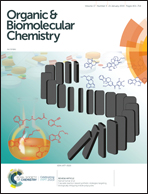A dual modality 99mTc/Re(i)-labelled T140 analogue for imaging of CXCR4 expression†
Abstract
The C–X–C chemokine receptor 4 (CXCR4) has been shown to be overexpressed in at least 23 types of cancer, including prostate cancer which has been shown to have a significant distinction of expression rates between cancerous compared to healthy or benign tissue. In an attempt to exploit the difference in expression, we have synthesized a derivative of T140, a peptide antagonist for CXCR4, containing a fluorescent 4-amino-1,8-naphthalimide appended with a di-(2-picolyl)amine binding unit to chelate rhenium or technetium-99m for fluorescence or SPECT imaging. The rhenium-coordinated variant was shown to have similar binding affinity for the receptor as T140 and showed specific uptake by fluorescence microscopy in CXCR4 expressing cells. The peptide was radiolabelled with technetium-99m in decay corrected radiochemical yields ranging from 60–85%, radiochemical purities >95%, and molar activities of 36–44 GBq μmol−1. The technetium-99m labelled peptide showed two-fold higher uptake in U87 cells expressing CXCR4 compared to non-transfected cells. Ex vivo biodistribution studies were performed using the technetium-99m labelled peptide in NOD/SCID mice bearing tumors derived from U87 cells with CXCR4. Tumor uptake of 0.51 ± 0.09% ID g−1 was observed two-hours post-injection. Our novel T140 derivative is suitable for imaging of CXCR4 expression by confocal microscopy. Further structural modifications to the peptide or metal complex may result in improved biodistribution for use in SPECT imaging of CXCR4 expressing tumors.

- This article is part of the themed collection: Chemical Biology in OBC


 Please wait while we load your content...
Please wait while we load your content...